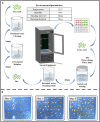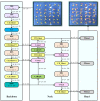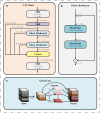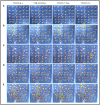YOLOv8-Peas: a lightweight drought tolerance method for peas based on seed germination vigor
- PMID: 37841608
- PMCID: PMC10568755
- DOI: 10.3389/fpls.2023.1257947
YOLOv8-Peas: a lightweight drought tolerance method for peas based on seed germination vigor
Abstract
Introduction: Drought stress has become an important factor affecting global food production. Screening and breeding new varieties of peas (Pisum sativum L.) for drought-tolerant is of critical importance to ensure sustainable agricultural production and global food security. Germination rate and germination index are important indicators of seed germination vigor, and the level of germination vigor of pea seeds directly affects their yield and quality. The traditional manual germination detection can hardly meet the demand of full-time sequence nondestructive detection. We propose YOLOv8-Peas, an improved YOLOv8-n based method for the detection of pea germination vigor.
Methods: We constructed a pea germination dataset and used multiple data augmentation methods to improve the robustness of the model in real-world scenarios. By introducing the C2f-Ghost structure and depth-separable convolution, the model computational complexity is reduced and the model size is compressed. In addition, the original detector head is replaced by the self-designed PDetect detector head, which significantly improves the computational efficiency of the model. The Coordinate Attention (CA) mechanism is added to the backbone network to enhance the model's ability to localize and extract features from critical regions. The neck used a lightweight Content-Aware ReAssembly of FEatures (CARAFE) upsampling operator to capture and retain detailed features at low levels. The Adam optimizer is used to improve the model's learning ability in complex parameter spaces, thus improving the model's detection performance.
Results: The experimental results showed that the Params, FLOPs, and Weight Size of YOLOv8-Peas were 1.17M, 3.2G, and 2.7MB, respectively, which decreased by 61.2%, 61%, and 56.5% compared with the original YOLOv8-n. The mAP of YOLOv8-Peas was on par with that of YOLOv8-n, reaching 98.7%, and achieved a detection speed of 116.2FPS. We used PEG6000 to simulate different drought environments and YOLOv8-Peas to analyze and quantify the germination vigor of different genotypes of peas, and screened for the best drought-resistant pea varieties.
Discussion: Our model effectively reduces deployment costs, improves detection efficiency, and provides a scientific theoretical basis for drought-resistant genotype screening in pea.
Keywords: YOLOv8; drought tolerance; lightweight; pea seed; seed vitality.
Copyright © 2023 Jiang, Hu, Fu, Chen, Wang, Tian and Shi.
Conflict of interest statement
The authors declare that the research was conducted in the absence of any commercial or financial relationships that could be construed as a potential conflict of interest.
Figures














Similar articles
-
Evaluation of cucumber seed germination vigor under salt stress environment based on improved YOLOv8.Front Plant Sci. 2024 Sep 13;15:1447346. doi: 10.3389/fpls.2024.1447346. eCollection 2024. Front Plant Sci. 2024. PMID: 39354946 Free PMC article.
-
A lightweight Yunnan Xiaomila detection and pose estimation based on improved YOLOv8.Front Plant Sci. 2024 Jun 5;15:1421381. doi: 10.3389/fpls.2024.1421381. eCollection 2024. Front Plant Sci. 2024. PMID: 38903433 Free PMC article.
-
High accuracy identification of maize seed varieties based on a lightweight improved YOLOv8.Sci Rep. 2025 May 27;15(1):18541. doi: 10.1038/s41598-025-00499-0. Sci Rep. 2025. PMID: 40425696 Free PMC article.
-
Heat stress tolerance in peas (Pisum sativum L.): Current status and way forward.Front Plant Sci. 2023 Jan 17;13:1108276. doi: 10.3389/fpls.2022.1108276. eCollection 2022. Front Plant Sci. 2023. PMID: 36733601 Free PMC article. Review.
-
Seed Priming: A Feasible Strategy to Enhance Drought Tolerance in Crop Plants.Int J Mol Sci. 2020 Nov 4;21(21):8258. doi: 10.3390/ijms21218258. Int J Mol Sci. 2020. PMID: 33158156 Free PMC article. Review.
Cited by
-
An exploration of the influence of ZnO NPs treatment on germination of radish seeds under salt stress based on the YOLOv8-R lightweight model.Plant Methods. 2024 Jul 23;20(1):110. doi: 10.1186/s13007-024-01238-8. Plant Methods. 2024. PMID: 39044226 Free PMC article.
-
RT-DETR-SoilCuc: detection method for cucumber germinationinsoil based environment.Front Plant Sci. 2024 Aug 22;15:1425103. doi: 10.3389/fpls.2024.1425103. eCollection 2024. Front Plant Sci. 2024. PMID: 39239193 Free PMC article.
-
Lightweight cotton diseases real-time detection model for resource-constrained devices in natural environments.Front Plant Sci. 2024 Jun 6;15:1383863. doi: 10.3389/fpls.2024.1383863. eCollection 2024. Front Plant Sci. 2024. PMID: 38903431 Free PMC article.
-
A method for detecting the rate of tobacco leaf loosening in tobacco leaf sorting scenarios.Front Plant Sci. 2025 Jun 5;16:1578317. doi: 10.3389/fpls.2025.1578317. eCollection 2025. Front Plant Sci. 2025. PMID: 40538881 Free PMC article.
-
YOLOv8-segANDcal: segmentation, extraction, and calculation of soybean radicle features.Front Plant Sci. 2024 Jul 11;15:1425100. doi: 10.3389/fpls.2024.1425100. eCollection 2024. Front Plant Sci. 2024. PMID: 39055355 Free PMC article.
References
-
- Barredo Arrieta A., Díaz-Rodríguez N., Del Ser J., Bennetot A., Tabik S., Barbado A., et al. (2020). Explainable Artificial Intelligence (XAI): Concepts, taxonomies, opportunities and challenges toward responsible AI. Inf. Fusion 58, 82–115. doi: 10.1016/j.inffus.2019.12.012 - DOI
-
- Bochkovskiy A., Wang C. Y., Liao H. Y. M. (2020). YOLOv4: Optimal speed and accuracy of object detection. arXiv preprint. doi: 10.48550/arXiv.2004.10934 - DOI
-
- Chen J., Kao S. H., He H., Zhuo W., Wen S., Lee C. H., et al. (2023). “Run, don’t walk: chasing higher FLOPS for faster neural networks,” in: Proceedings of the 2023 IEEE/CVF Conference on Computer Vision and Pattern Recognition (Piscataway, NJ: IEEE; ). 12021–12031.
-
- Chollet F. (2017). “Xception: deep learning with depthwise separable convolutions,” in: Proceedings of the 2017 IEEE Conference on Computer Vision and Pattern Recognition, (Piscataway, NJ: IEEE; ), 1800–1807.
-
- Cousin R. (1997). Peas (Pisum sativum L.). Field Crops Res. 53, 111–130. doi: 10.1016/S0378-4290(97)00026-9 - DOI
LinkOut - more resources
Full Text Sources

